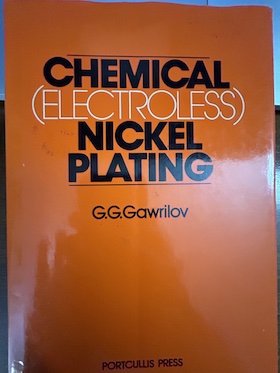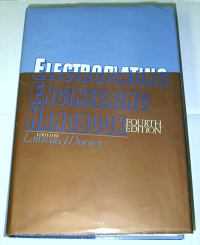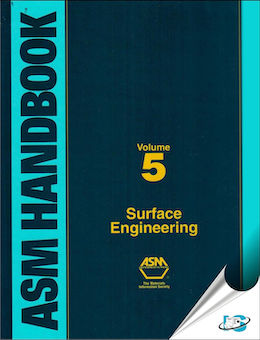
-----
Cycle for Electroless Nickel Plating on Molybdenum?
Q. Dear reader,
We've encountered some problems on plating electroless nickel onto molybdenum. All the pre-treatments that we know of need the use of current in some way or another. We are looking for a current-free pretreatment because the tubes we want to plate have such small inner diameters that current won't pass. We've been plating these tubes successfully when they were made of steel, but the molybdenum ones are giving trouble. We'd be glad to receive any suggestions.
R. Kunzler- Netherlands
1998
by G. G. Gawrilov

on eBay or Amazon
or AbeBooks
(affil link)
A. Gawrilov's book, Gawrilov's Chemical (Electroless) Nickel Plating ⇦[this on Amazon, ... on AbeBooks affil links], says that Mo pretreatment "can take place in alkaline solutions containing potassium ferricyanide; HCl, HF and mixtures of nitric and sulfuric acid". Also, you need contact of aluminum or magnesium for Ni-P plating. He gives german and russian references, and a patent DOS 2046521.

Tom Pullizzi
Falls Township, Pennsylvania
1998
1998
A. The trick here is to lay down a strike (cap-off) layer of "anything" at a rate sufficient to out-pace the rate of oxidation of the Mo substrate. As far as I know, there are no E-less processes capable of it and I've tried them all on high aspect-ratio Mo surfaces. Adhesion of the cap-off layer always suffers unless it it applied RAPIDLY, and I mean in just a few seconds on Mo.
Unfortunately, this means you must push the rates with DC current, and you must introduce reactant along the surface at even higher rates to support this high current. There is a trick you may be able to get by with if adhesion is not of great concern. There are "Immersion" Gold treatments available Technic, Inc. Oromerse) which deposit approx. 5 microinches of Au, sufficient to get an E-less Ni process started. Your long aspect ratio may provide mechanical adhesion of the interior deposits once the Nickel is applied. You experiment (play around) with that bath a bit and you may be able to find parameters that yield sufficient adhesion, assuming that Gold is allowed directly on the Mo by your Materials Engineers.
Good Luck,
Dave,
SUNNYvale, CA

Dave Kinghorn
Chemical Engineer
SUNNYvale, California
How to do nickel strike on Mo
Q. I need to to nickel plate a molybdenum surface in preparation for electroless gold. Can anyone tell how to put a nickel strike coat onto molybdenum?
James A. MacKenzieUBC Dept. of Physics - Vancouver, B.C., Canada
1999
Ed. note: We've appended your inquiry to an earlier thread where Dave Kinghorn has offered some insightful advice.
A. Mr. MacKenzie: We nickel plate tungsten wires using a potassium hydroxide cleaning and a nickel sulfamate strike and plate. This should work well for molybdenum also. -Kirk
Kirk O'Brien- Colorado
1999
A. I have plated Nickel on molybdenum using the sequence given in handbook edited by A.K.Graham. It worked fine.
Yashawant Devalelectroplating shop. - Pune, Maharashtra, India
1999
Ed. note: the current edition of Graham's Electroplating Engineering Handbook ⇦ this on eBay, AbeBooks, or Amazon [affil link] is edited by Durney.
Proper Pretreatment for Electroless Plating?
Q. I need electroless nickel coating on molybdenum parts. I tried several pretreatment procedures (incl. Wood's nickel strike) without success - the coats were not adherent. Please help.
Frantisek HaasR&D engineer - Jablonec kraj, Czech republik
2003
A. Molybdenum has a very tenacious oxide layer that is very difficult to remove. Its structure is extremely complex and varied. However, a description on how to electroplate onto molybdenum is given in Graham's Electroplating Engineering Handbook (most recently edited by Durney) and in ⇦[this on eBay, AbeBooks, or Amazon affil links] . I would have concerns about depositing electroless nickel onto molybdenum because of the slow rate of metal deposition, the lack of polarization and the rapid formation of molybdenum oxides. You may be better off trying to put down a protective electrolytic metal and then electroless nickel

Trevor Crichton
R&D practical scientist
Chesham, Bucks, UK
2003
2003
A. Earl Groshart stated in the 1991 Metal Finishing Guidebook that molybdenum could be plated by the following procedure:
1. Degrease in steel soak and electrocleaners
2. Anodic treatment in 885 g/L sulfuric acid plus 720 g/L phosphoric acid at 7-8 A/dm2 for 2-3 min
3. Etch in 300 g/L potassium ferricyanide plus 100 g/L potassium hydroxide at 85 °C for 1/2-1 minute
4. Strike in a standard chromium plating bath
5. Strike in chloride nickel strike The part should be rinsed between steps.
I have never tried this myself. Good luck.

Ron Duncan [deceased]
- LaVergne, Tennessee
It is our sad duty to note Ron's passing on Dec. 15, 2006. A brief obituary opens Episode 13 of our Podcast.
Electrodeposition of Ruthenium onto Molybdenum
Q. Dear Reader,
I am working for an electroplaters and am trying to find out how you can deposit a THICK coating of ruthenium (of high quality) onto a hard metal such as molybdenum, something in the region of 10-20 microns. Preferably this would employ an electroplating technique, but could use electroless plating if necessary.
Any help would be much appreciated!
Technical Researcher - Corby, U.K.
June 27, 2008
A. I suspect your problem is not the ruthenium, but the molybdenum. There are many electroplating baths that will deposit ruthenium (e.g., see patents WO1992/17625 and US Patent 4375392). The trick is to make sure the molybdenum is free of oxides and other substances that will stop the ruthenium from depositing.

Trevor Crichton
R&D practical scientist
Chesham, Bucks, UK
July 31, 2008
Striking with chrome is the only thing that works! :-(
Q. I am a student at a University and I am currently trying to find a way to electroplate either Nickel or Copper directly onto Molybdenum so that we can solder the plate afterwards. I have found books and articles on electroplating Nickel but they all require plating Chromium so that there is good adhesion but Chromium is not an option for me. Is there any way to plate Nickel directly onto Molybdenum with good adhesion, and if not, then is there any way to electroplate copper directly onto Molybdenum with good adhesion.
Thanks
student - Irvine, California, USA
2006
Q. I need to find a plating procedure for Gold over Molybdenum. I have searched almost every technical book or article on the subject, however very little is mentioned. Of the hundreds of sources, they all mention using Hexavalent Chromium as a Strike. This is usually followed with Nickel Chloride Strike, then gold.
I have used this method in the past with great success, However I have been experimenting with eliminating the Chromium by using various acidic pretreatments, Or bead blasting, followed by a Nickel chloride strike then gold.
I have not found any process so far that even comes close to the Hexavalent Chromium pretreatment in terms of adhesion. It seems that Hexavalent and now even Trivalent Chromium is frowned upon because of ever increasing environmental regulations regarding its use. Any suggestions?
Brian B [last name deleted for privacy by Editor]- Rancho Cordova, California, USA
2002
|
2002 "Any suggestions?"
I mean, you've employed the scientific method ... you've spent tremendous investigatory effort, studied all the books, exhausted the alternate possibilities, learned what the only right process is ... and experimentally confirmed your research. Then, just to be extra sure, you've submitted your situation for an informal peer review by the luminaries of the finishing world from every corner of the globe to see if there is anything you could have possibly missed, and been assured that you haven't. Now, all you want to do is to use, in a safe manner, a material which poses no danger at all when safely used. Do it.  Ted Mooney, P.E. Striving to live Aloha finishing.com - Pine Beach, New Jersey Ted is available for instant help or longer-term assistance. Thanks For your response, I agree with you. I only wish I could convince a large number of highly educated individuals, engineers, scientists, etc., of the same. I find too often that there is an exaggerated fear about many of the chemical processes that are absolutely essential in the metal finishing industry. Used in a professional and safe manner or not, just the mentioning of the word Hexavalent Chrome, or cyanide for example, sends most people into an instant panic. As a result, many of these chemicals are targeted for elimination by various agencies or individuals. Thus sending myself and other professionals into a desperate quest to find suitable replacements. Sincerely, Brian B [last name deleted for privacy by Editor]- Rancho Cordova, California, USA 2002 While I sympathize, I'd rather be you than the guy who succumbs to the pressure :-) Regards,  Ted Mooney, P.E. Striving to live Aloha finishing.com - Pine Beach, New Jersey Ted is available for instant help or longer-term assistance. |
Maybe "jet plating" nickel onto molybdenum? will work
Q. We are contemplating Nickel/Gold plating on Molybdenum chem milled sheets. Is it an absolute to use a sintering oven to promote adhesion of the Nickel and, if so, does it have to be a hydrogen atmosphere to resist oxidation? Also, what temperatures/time are we talking about for the sintering process?
GARY HEINVP SALES/PLATING JOB SHOP - BREA, California, USA
October 24, 2008
A. An earlier response to a similar question has highlighted the existence of details of electroplating onto molybdenum in a chapter on surface engineering in Vol. 5 of the ASM International Metals Handbook. There are also a couple of patents on plating onto molybdenum (e.g., US Pat 3,386,896); this particular one uses gold as the coating agent and stresses that since molybdenum has a strong propensity to form a wide range of oxides, after the gold strike has been put down, the coated molybdenum sheet should be heat treated to reduce the oxides.
Having dabbled a bit with molybdenum in the distant past, I too found it was a strong oxide producer and was a real problem to get an adherent coating onto it. Giving it better consideration and with the benefit of hindsight, I can see the sense in using a sinter or reduced atmosphere heat treatment.
One thing that has occurred to me is that it may be possible to directly electroplate molybdenum by using jet plating. I know I was successful in directly jet plating nickel onto a piece of dirty aluminium that I didn't even bother to clean, so I could see that the technique could perhaps eliminate the need for specialised heat treatments with molybdenum. Maybe it is worth a go?

Trevor Crichton
R&D practical scientist
Chesham, Bucks, UK
November 6, 2008
Will Nickel Plating onto Molybdenum Survive Brazing Temperatures?
Q. I am trying to Nickel Plate onto Molybdenum.
Once plated, the Plated Molybdenum will be brazed onto another Pure Nickel rod
using Gold-Nickel alloy @ 1000 °C.
I need to know if the Nickel Plated Molybdenum will be stronger in bonding strength
than the brazed part, and if the plating will withstand brazing temperatures.
- South Korea
November 10, 2013
A. Hello Kay,
The bond strength of the Ni plated Moly would only be as good as the pre-plate and Ni plating process employed. I have seen that Ni sulfamate baths have a better success rate than standard watts baths in brazing applications. I would have to say that the bond strength would be greater on the brazed part itself. The Ni plating should hold up to the brazing temps you described. I think the biggest hurdle you are going to have is to nail down a process for the plating on Moly. Hope this helps.
Process Engineer - Malone, New York, USA
November 20, 2013
Q, A, or Comment on THIS thread -or- Start a NEW Thread

